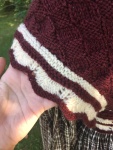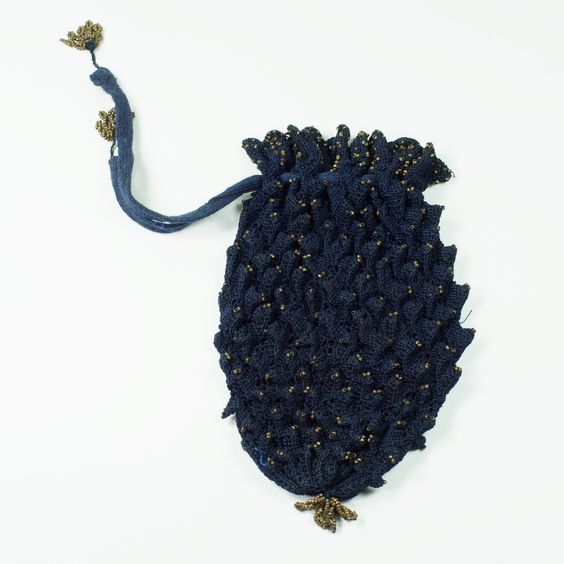
What is a pineapple stitch?
I learned very basic knitting in college and then put it down for *mumblty* years because I got distracted by something shiny and wandered away, but a few years ago I started to get the historical knitting itch. Largely based on seeing the amazing projects Katherine was always making. Top on my list was a knitted pineapple reticule.

The famous Kyoto knitted pineapple reticule
Popular starting around the turn of the 19th century up till the 1840s several extant pineapples exist as well as a few versions of the pattern. The most commonly used pattern is from Jane Gaugain’s The Lady’s Assistant for Executing Useful and Fancy Designs in Knitting, Netting and Crochet Work (1840). “I could never knit one of those though right? that looks really complicated”
Incorrect! Once Katherine talked me into facing the pattern…why it’s actually quite simple! The same basic stitch makes both the leaves and the knobby, bumpy, whatsits. The body is knit inside out and you offset the rows. If you learn the one stitch you can knit the whole thing…and that’s when a new world opened as I realized…that stitch? It pops up everywhere in historical knitting. And why not? It’s easy, it’s versatile and if there’s one thing living history has taught me it’s that the crafty ladies who came before us? They were very ingenious at making things LOOK more complicated then they are.
When done flat pineapple stitch makes up as a chevron. The first rows are pulled into a zig-zag edge by the decreases. On the pineapple this makes the top edging. But on other projects this is used as the bottom to give trim a dagged edge.

So without further ado I present to you the examples I’ve come across of what I’m calling “Pineapple stitch” stay tuned to the end for the simple instructions so you too can knit adorable lacy edges.
Reticules
This one is fairly logical. Of course someone said “oh I love a spiky bag with those funny knobby whatsits but I dislike pineapple colours what else can I do”

A navy spiky reticule sold by Ruby Lane. This example has two beads on each whatsit.

Another “spiky” pineapple stitch reticule from the V&A museum 1800-1829.

Rainbow reticule 1800-1849 at the V&A museum. This one has no beads and unlike the pineapple reticule it’s not worked inside out for the section with the whatsits.

Knitted reticule sold on Ruby Lane. I’m not 100% sure this is the same stitch as I can’t tell in the photo but I suspect it is. And I enjoy the jingle bell on the end.

All yellow spiky reticule sold by Meg Andrews Auction.

Reticule 1810-1825 from the MET. I shall call it the flying saucer reticule
Petticoats
I know this one seems a little farther afield but bear with me. The bottom rows of this Godey’s knitted petticoat pattern? The exact same stitch as the pineapple.

Godey’s 1864 knitted under petticoat pattern

Knitted petticoat from the Missouri Historical Society. Those five bottom pattern repeats? you guessed it. Pineapple stitch.

knitted under-petticoat from the Wisconsin Historical Society.

Sample book of stitches from the V&A Dated 1825-1840. Top left corner is the pineapple stitch. Also to the right of it is a swatch for what the Godey’s pattern uses for the next band of trim. I suspect this knitter had that issue.

My example of the Godey’s Patten
Knitted Talma
Do you feel like doing a metric TON of pineapple stitch? Well for maximum impact may I suggest the giant knitted talma?

Peterson’s 1859 Knitted Talma

1860s tintype of a woman in a knitted talma very similar to the 1859 Peterson’s pattern
Sontag
What really inspired this post was the trim I made for a recent sontag based on this tintype. The lace is a border of pineapple stitch followed by two stripes of “plain knitting” or garter stitch.

Mid-Victorian tintype, the lace edging is pineapple stitch

This is four rows or burgundy, a section of pineapple (I forget how many rows), four rows of burgundy and four rows of white. Then I cast off and sewed it to the edge.
How To:
And now the moment you’ve all been waiting for:
k1, yo, k3-5 sl1-k2tog-psso, k3-5, yo repeat to the end. k1.
If knitting in the round then just continue the pattern, if you’re knitting flat purl all stitches on the wrong side.
Okay let me write that out for people who might need more instruction. I’ve seen patterns call for between 3 and five stitches for the width of the repeat. It doesn’t matter as long as you’re consistent and they mirror. I will use 3 stitches in the below example but you can vary as long as it’s consistent.
Most variations start with one or two rows of plain knitting often in a contrasting color. If you don’t want to do that just do a cast on in number divisible by your repeat. In this example divisible by 10 + 1 as you need the end of the repeat to be a yarn over.

The bottom most edge is the cast on edge. You’re working bottom to top. So four rows of plain knitting in burgundy is the start of this pattern.
Yarn over, knit one, yarn over, Knit 3 stitches, slip the next stitch, knit two stitches together, pass the slipped stitch over the two knitted together. You’re creating a triple decrease. knit 3 stitches. yarn over, knit one, yarn over. Start back with your 3 stitches and repeat the pattern to the end.
Summary
I hope this helps make a fun lace edging and very versatile stitch accessible for some people. I will continue to add examples if I find more….Anyone seen pineapple stitch anywhere else?
Also does anyone know it’s real name? I mean I call it pineapple stitch but I suspect it has a real name.
And I have to thank the amazing Katherine for all her help both in this post and supporting a new knitter!




























